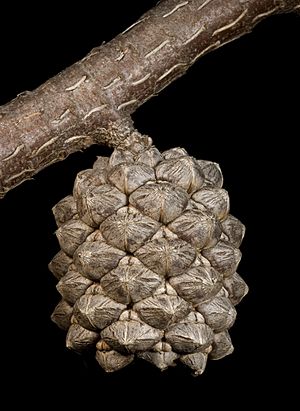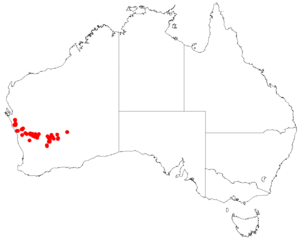Northern sheoak facts for kids
Quick facts for kids Northern sheoak |
|
|---|---|
 |
|
| Scientific classification | |
| Genus: |
Allocasuarina
|
| Species: |
dielsiana
|
 |
|
| Occurrence data from AVH | |
The Northern sheoak, also known by its scientific name Allocasuarina dielsiana, is a special kind of tree. It belongs to the Allocasuarina family. This tree is native to the Mid West and Goldfields-Esperance areas of Western Australia.
This tree can grow quite tall, usually reaching between 4 and 9 meters (about 13 to 30 feet) high. You can often find it growing in hilly areas, especially where the soil is stony and red, often over granite rocks.
Contents
Meet the Northern Sheoak!
The Northern sheoak is a unique tree from Western Australia. It's known for its interesting appearance and where it chooses to grow. These trees are an important part of the Australian landscape.
Where Does It Grow?
The Northern sheoak calls the Mid West and Goldfields-Esperance regions of Western Australia home. It likes to grow in tough places. You'll often spot it on hillsides. It prefers stony red soil that sits on top of granite rock. This shows how tough and adaptable this tree is!
How Big Does It Get?
Imagine a tree that can be as tall as a two or three-story building! The Northern sheoak typically grows to be between 4 and 9 meters (about 13 to 30 feet) tall. This makes it a medium-sized tree.
About Its Name
The Northern sheoak has an interesting history when it comes to its name. It was first described by a botanist named Charles Austin Gardner in 1936. He first called it Casuarina dielsiana.
Later, in 1982, another botanist, Lawrence Alexander Sidney Johnson, reclassified it. He moved it to a different group of trees called Allocasuarina. This is why its full scientific name is now Allocasuarina dielsiana. Scientists sometimes change names as they learn more about plants.
Reproduction of the Northern Sheoak
The Northern sheoak is a dioecious tree. This means it has separate male and female plants. One tree will produce only male flowers, and another tree will produce only female flowers. For seeds to be made, pollen from a male tree needs to reach a female tree. This is a common way many plants reproduce.

